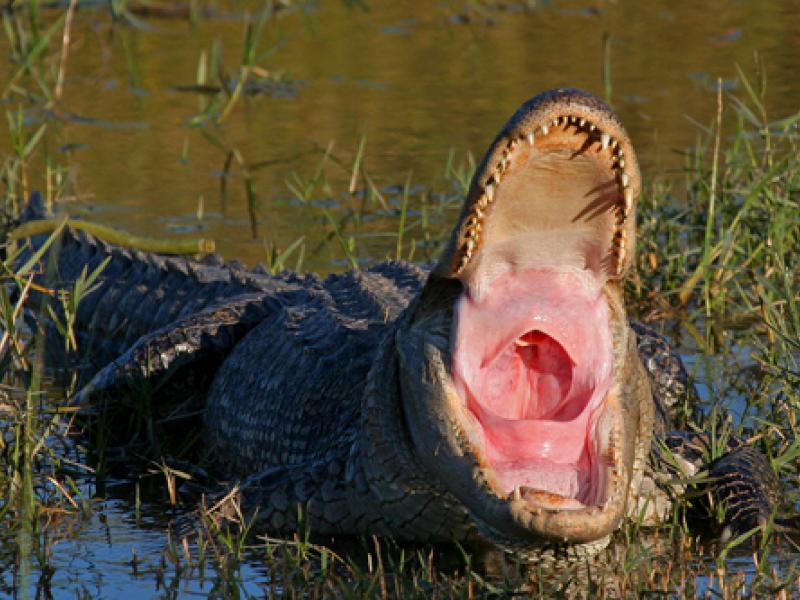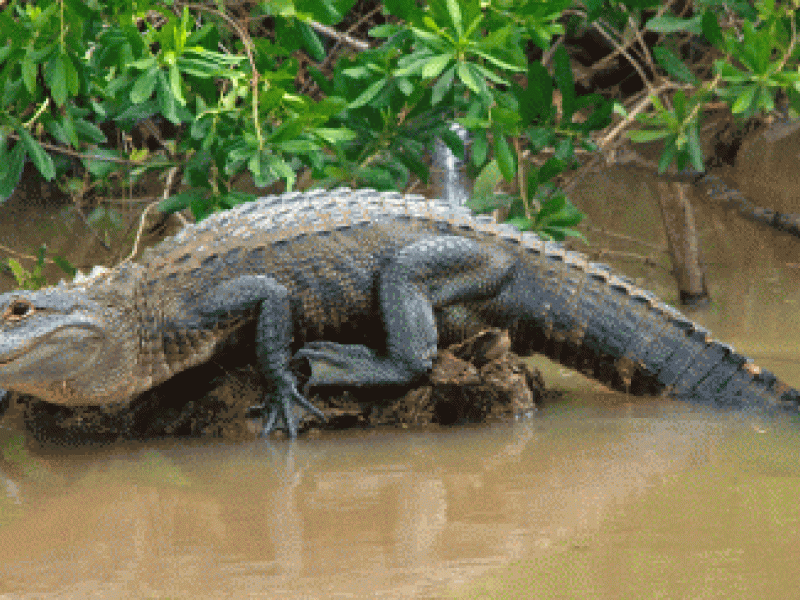Photos by Rick Dowling (left) and Kathy Hicks
Alligator Hunting Season Information
SCIENTIFIC NAME:
Alligator mississippiensis
DESCRIPTION:
The American alligator is one of the largest reptiles in the world. Males can grow to 19 feet in length and weigh up to 900 pounds, while females tend to be somewhat smaller on average. Their entire bodies are covered with large horny plates which protect them from predators and other alligators. They have short legs with five toes joined by webbing at the base on their front legs and four webbed toes on the back legs. They have a broad head with a short rounded snout. Their eyes, ears and nostrils are located on top of their head so they can use them without being completely emerged from the water. They have valves to close their ears and nostrils when submerged allowing them to stay under water for 45 – 60 minutes. Their tails are usually at least half their body length and laterally flattened which helps propel them through the water. They have large jaws with 80 teeth that aid in capturing and killing their prey.
DISTRIBUTION:
American alligators are found from the southern border of Virginia and North Carolina down the eastern seaboard of the U.S. and westward along the Gulf of America to Texas and throughout Central America. The state of Florida has by far the largest population of American alligators in the United States.
HABITAT:
American Alligators can be found throughout their range in freshwater swamps, marshes, rivers, lakes and streams. They prefer water sources that do not go dry in the summer months and that provide an abundance of food.
FEEDING HABITS:
Alligators are carnivorous, feeding mostly on fish, birds, snakes, turtles and small mammals. They feed mostly at night. Their large teeth assist with catching their prey. Alligators are unable to chew their food so they must swallow it whole or in large chunks. They usually lie and wait for a meal to come by, then capture and drown it. If given the opportunity to capture large prey, they will drag it underwater and lodge it beneath logs or stumps and come back later to finish it off. They must return to the surface to consume it since they cannot swallow under water. An adult alligator will eat 20 pounds of food a week during warm weather but can go for weeks without eating during the winter. Young alligators will eat insects, worms, small fish and frogs.
LIFE HISTORY AND ECOLOGY:
American alligators were once pushed to the brink of extinction by market hunters and trappers who sold their hides and meat. In the 1970s laws were passed to protect them and they were placed on the endangered species list. Since then, due to significant conservation efforts, the American alligator has been restored throughout much of its original range. It is no longer an endangered species but is still listed as threatened due to its resemblance to the American Crocodile which is still listed as endangered. American alligators have an extremely high reproduction rate which has also helped in its restoration.
Mating season for alligators is April through May and breeding occurs in open water. After conception, the female will construct a nest of vegetation and mud where she will lay 30 – 70 eggs. She will then cover them with a mound of vegetation that serves as an incubator for the eggs. The temperature inside the mound determines the sex of the young with more males being produced at higher temperatures. Eggs typically hatch after nine weeks. Once hatched, the young alligators begin to make a squeaking sound which stimulates the mother to break open the nest and lead them to the water. The young are about nine inches long at birth and will stay with the mother for 18 months until she hatches the next year’s litter. Alligators grow about one foot per year for the first four years of their life. When they reach six feet in length most alligators are sexually mature. Because they typically grow faster, males tend to reach sexual maturity earlier than females.
REFERENCES:
Britton, A. 1999 “Alligator Mississippiensis in the Crocodilians, Natural History and Conservation (On-line) www.flmnh.ufl.edu/cnhc/csp-amis.html
Godwin, M. 1999. “The Gator Hole”
Ross, C. 1989 “Crocodiles and Alligators” New York, New York: Facts on File, Inc.
AUTHOR:
Adam Pritchett, Wildlife Biologist, Alabama Division of Wildlife and Freshwater Fisheries







